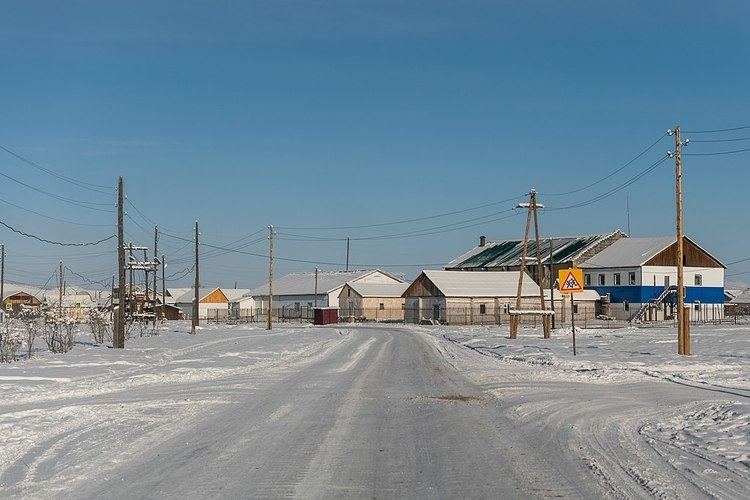Administrative district Oymyakonsky District Time zone VLAT (UTC+10:00) | Federal subject Sakha Republic Population (July 17, 2011 est.) 500 inhabitants Local time Wednesday 10:56 AM | |
 | ||
Municipal district Oymyakonsky Municipal District Weather -13°C, Wind NE at 0 km/h, 94% Humidity Similar Bereg Yurdya, Delyankir, Khara Tumul | ||
Walking in yakutsk oymyakon siberia yakutia russia at 50c december 2014
Oymyakon (Russian: Оймяко́н, [ɐjmʲɪˈkon]; Yakut: Өймөкөөн, Öymököön, [øjmøˈkøːn]) is a rural locality (a selo) in Oymyakonsky District of the Sakha Republic, Russia, located along the Indigirka River, 30 kilometers (19 mi) northwest of Tomtor on the Kolyma Highway. Oymyakon is one of the coldest permanently inhabited locales on Earth.
Contents
- Walking in yakutsk oymyakon siberia yakutia russia at 50c december 2014
- Map of Oymyakon Sakha Republic Russia 678750
- Coldest village on earth is oymyakon russia
- Etymology
- Geography
- History
- Climate
- In the media
- References
Map of Oymyakon, Sakha Republic, Russia, 678750
Coldest village on earth is oymyakon russia
Etymology
It is named after the Oymyakon River, whose name reportedly comes from the Even word kheium, meaning "unfrozen patch of water; place where fish spend the winter." However, another source states that the Even word heyum (hэjум) (kheium may be a misspelling) means "frozen lake".
Geography

Oymyakon, population 500, is in eastern Yakutia at approximately 750 meters above sea level. At the village's northerly position, day length varies from three hours in December to twenty-one hours in June.
History
During World War II, an airfield was built here for the Alaska-Siberian (ALSIB) air route used to ferry American Lend-Lease aircraft to the Eastern Front.
Climate
With an extreme subarctic climate (Köppen climate classification Dwd), Oymyakon is known as one of the candidates for the Northern Pole of Cold, the other being the town of Verkhoyansk. The ground there is permanently frozen (continuous permafrost).
On February 6, 1933, a temperature of −67.8 °C (−90 °F) was recorded at Oymyakon's weather station. Only Antarctica has recorded lower official temperatures (the lowest being −89.2 °C (−128.6 °F), recorded at Vostok Station on 21 July 1983.)
The weather station is in a valley between Oymyakon and Tomtor. The station is at 750 meters (2,460 ft) and the surrounding mountains at 1,100 meters (3,600 ft), causing cold air to pool in the valley: in fact, recent studies show that winter temperatures in the area increase with altitude by as much as 10 °C (18 °F).
Sometimes the temperature drops below 0 °C (32 °F) in late September and may remain below freezing until mid-May. In Oymyakon sometimes the average minimum temperature for January, February and December remains below −50 °C (−58 °F). Sometimes summer months can also be quite cold, but June and July are the only months where temperature has never dropped below −10 °C (14 °F). Oymyakon, Verkhoyansk and Yakutsk are the only three permanently inhabited places in the world that have recorded temperatures below −60.0 °C (−76 °F) for every day in January.
Oymyakon has never recorded an above freezing temperature between October 25 and March 17.
Although winters in Oymyakon are long and excessively cold, summers are mild, sometimes with hot, and very hot, days. The warmest month on record is July 2010 with an average temperature of +18.7 °C (65.7 °F). In June, July and August temperatures over 30 °C (86 °F) are not rare during the day. On July 28, 2010, Oymyakon recorded a record high temperature of 34.6 °C (94 °F), yielding a temperature range of 102.3 °C (184.1 °F). Verkhoyansk and Yakutsk are the only other places in the world with a temperature amplitude higher than 100 °C (180 °F).
The climate is quite dry, but as average monthly temperatures are below freezing for seven months of the year, substantial evaporation occurs only in summer months. Summers are much wetter than winters.
In the media
Oymyakon has been featured in a number of television series:
